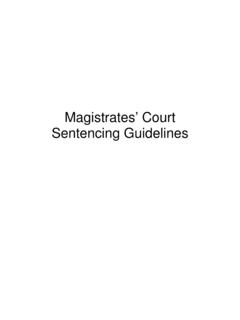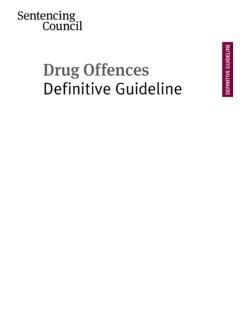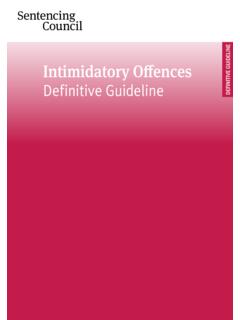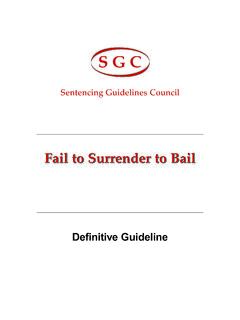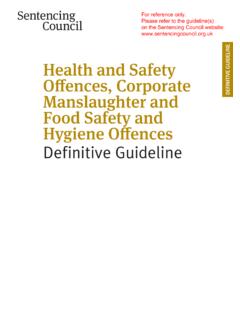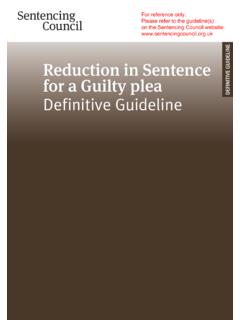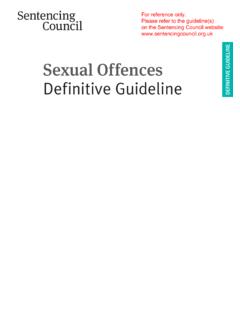Transcription of Murder sentencing leaflet
1 sentencing FOR Murder As Murder is such a serious crime, the approach to sentencing for this offence is set out in law. The judge must impose a life sentence and follow guidance on the minimum amount of time the offender must be in prison before being considered for release (this is sometimes referred to as the tariff). The harm caused by any offence that results in a death is immeasurable. The sentence is not a measure of the value put on the life of the victim. An offender is sentenced after he or she has either pleaded guilty to the offence or been found guilty following a trial. The judge may sentence immediately or may adjourn the case to obtain reports on the offender (for example medical reports). Setting the minimum prison term Depending on the facts of the offence the starting point for the minimum time served in prison for an adult ranges from 15 to 30 years.
2 For an offender under 18 the starting point is 12 years. It is unusual, but some offenders receive a whole life tariff, which means they will spend the rest of their life in prison. Parliament has set out in law the circumstances in which this can happen. To set the minimum term the judge will first consider which starting point applies to the case. For the purposes of setting the starting point for the minimum term the law sets out four categories. Here you will find examples of the types of cases that may fall into each category: In cases such as a carefully planned Murder of two or more people, or a Murder committed by an offender who had already been convicted of Murder the starting point for an offender aged 21 or over is a whole life tariff. For an offender aged 18-20 the starting point would be 30 years and for an offender aged under 18 it is 12 years.
3 In cases such as those involving the use of a firearm or explosive the starting point is 30 years for an offender aged 18 or over and 12 years for an offender aged under 18. In cases where the offender brings a knife to the scene and uses it to commit Murder the starting point is 25 years for an offender aged 18 or over and 12 years for an offender aged under 18. In cases that do not fall into the above categories the starting point is 15 years for an offender aged 18 or over and 12 years for an offender aged under 18. It is important to note that these are starting points only. Having set the minimum term, the judge will then take into account any aggravating or mitigating factors that may amend the minimum term either up or down. The judge may also reduce the minimum term to take account of a guilty plea.
4 The final minimum term will take into account all the factors of the case and can be of any length. Aggravating and mitigating factors Aggravating factors are things that make an offence even more serious and increase the minimum term. These include: a significant degree of planning or premeditation; the fact that the victim was particularly vulnerable because of age or disability; mental or physical suffering inflicted on the victim before death; the abuse of a position of trust; the use of duress or threats to enable the offence to take place; the fact that the victim was providing a public service or performing a public duty; and concealing, destroying or dismembering the body. Mitigating factors are things that may reduce the minimum term.
5 These include: an intention to cause serious bodily harm rather than to kill; lack of premeditation; the offender suffering from a mental disorder or mental disability which lowered his degree of blame; the fact that the offender was provoked (for example, by prolonged stress); the fact that the offender acted to any extent in self-defence or in fear of violence; a belief by the offender that the Murder was an act of mercy; and the age of the offender. What about the impact of the crime? In any case resulting in a death the impact of the offence will, of course, be assessed as very serious. If the victim s family has chosen to make a victim personal statement the judge will use the information it contains when assessing the impact of the crime.
6 A life sentence always lasts for the rest of the offender s life, no matter how long the tariff is. An offender will remain in prison for at least the minimum term. At the end of that term he or she can apply to the Parole Board for release on licence but would only be released if no longer considered to be a risk to the public. If released the offender would be subject to certain conditions and if the conditions are broken or if the offender is considered to be a risk to the public he or she will be sent back to prison. Decisions about prisoner release The Parole Board makes decisions about the early release of certain prisoners, including many who have committed violent offences, most offenders who have been recalled to prison, and anyone sentenced to life imprisonment or indeterminate sentence for public protection.
7 When making these decisions the Parole Board acts as a court, but does not hold public hearings. Some decisions are made on paper, others at oral hearings held at the prison. The Parole Board has specific duties that are set out in the Code of Practice for Victims of Crime. Useful sources of information The Code of Practice for Victims of Crime provides information for victims of crime and bereaved close relatives of a victim who has died as a result of a crime. Find out about sentencing guidelines and how they help judges decide on sentences. Judges must follow guidelines unless there are very good reasons - in the interests of justice - not to. In such a case, the judge has to give reasons. Find out more about how the Parole Board works to protect the public by risk assessing prisoners to decide whether they can be safely released into the community.
8 Here you will find the law that sets out examples of the different types of cases and the usual starting points for setting minimum sentences for the offence of Murder . This leaflet is one of a series of leaflets developed by the Office of the sentencing Council in partnership with the Family Liaison and Disaster Management Team at the Metropolitan Police. It is intended to be used by Family Liaison Officers to help explain to families of victims how certain serious offences are sentenced. Please contact: for further information.
